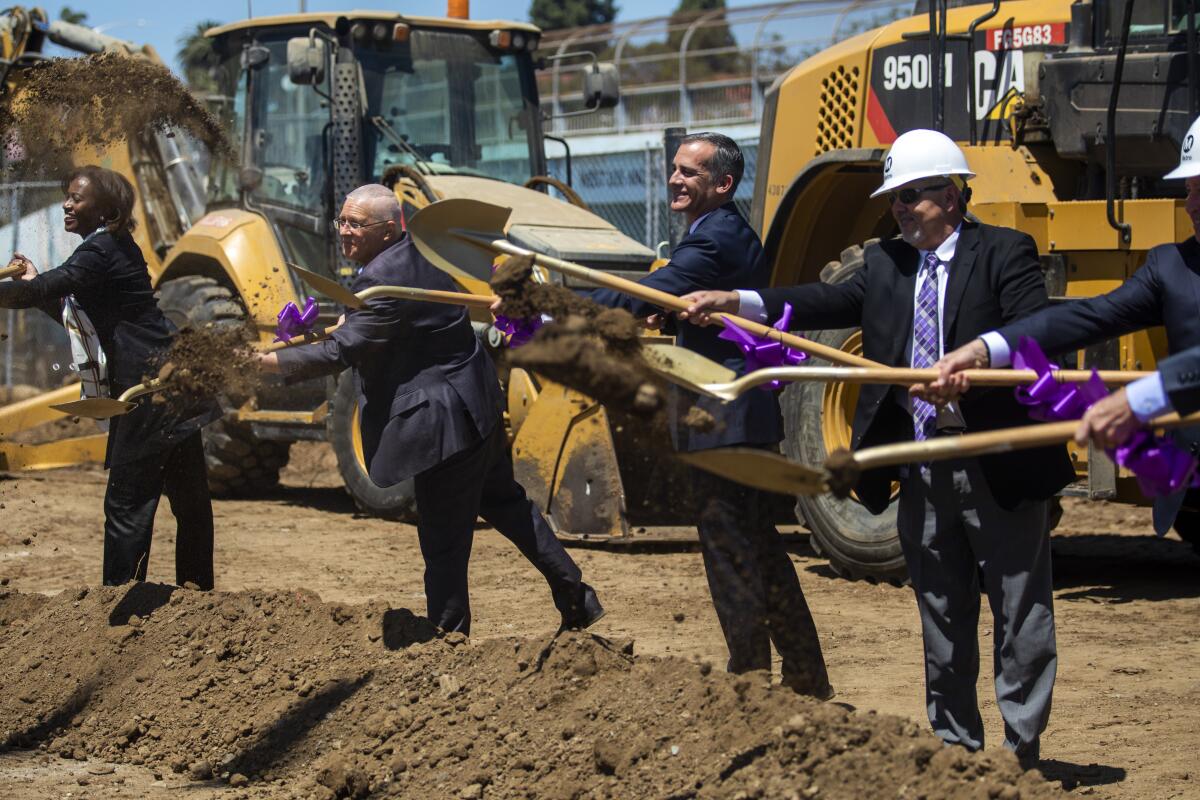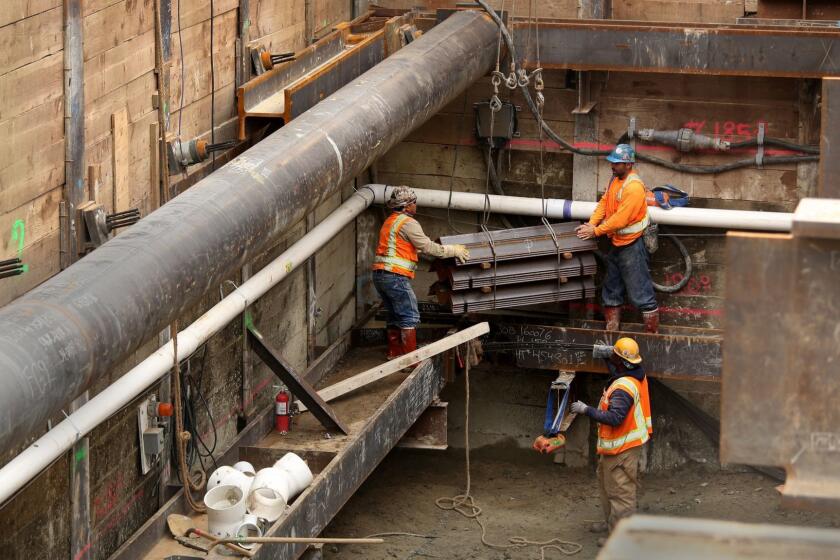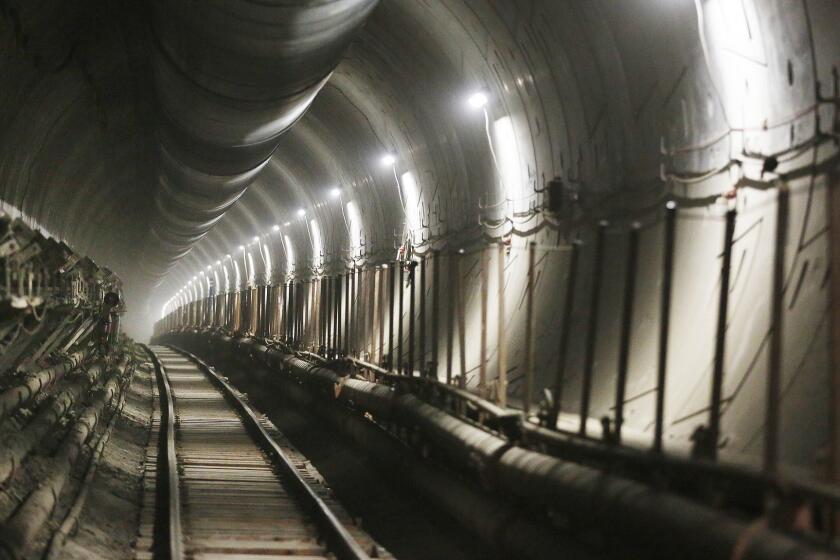L.A. turbo-charged subway, rail construction during pandemic. Will the riders return?

- Share via
It was a moment some longtime Angelenos never thought they’d see.
A group of politicians stood at a site on Wilshire Boulevard just west of the 405 Freeway to break ground on the final leg of a subway that will eventually take riders from downtown L.A. into the Westside.
The idea of mass transit under what is perhaps Los Angeles’ most iconic boulevard has been a dream for decades, but faced numerous obstacles including neighborhood opposition over crime and worries about explosive methane gas pockets.
But the slow march of the Purple Line west also underscores a larger mass transit boom that accelerated during the pandemic, even as ridership on buses and trains plummeted. Metro used the 70% ridership drop and reduced traffic caused by COVID-19 closures to push forward several projects, including the Wilshire subway.
“We took advantage of the opportunity,” L.A. Mayor Eric Garcetti said Monday, noting that the quiet streets also enabled the city to install bus lanes, address airport construction and close streets for up to 24 hours when needed. “We were able to do things that would have taken us six, seven months longer in a shorter period of time.”
The big question now is whether riders will return as the economy reopens — and how fast that would happen.
Transit officials are working on several mass transit projects at once — the Purple Line as well as the Crenshaw Line to LAX, the Central Connector subways in downtown L.A. and an extension of the Gold Line in the San Gabriel Valley. Several other lines are in the works thanks to an infusion of tax revenues approved by voters and with the hope of having a stronger transit network in place by the 2028 Olympics.
Metro officials believe riders will come back and that the bigger network of rail lines will make ditching the car a more viable option for others.
“As we open up these other lines, that ridership will increase,” Metro CEO Phillip A. Washington said after Monday’s groundbreaking ceremony, which was held at the site of the future Westwood/VA Hospital station in West L.A. “We’re bullish on transit, and we’re bullish on ridership returning.”
Before the pandemic, Metro was struggling to lure more riders on its buses and trains, with several years of declining ridership.
Washington said the agency had been carrying about 1.2 million rail and bus riders per day before the pandemic, but dipped down to about 363,000 at its low point in March last year. Now it’s “gradually coming back up” to about 700,000 people per day, he said.
The agency is exploring means to entice people to ride the train in a city notorious for its car culture, including options to offer ongoing fare-free transit to low-income residents and students. A 2019 agency survey found that Black and Latino riders made up 75% of Metro’s customers, and almost 70% of customers had an annual household income below $35,000.
“We have to break those barriers down,” Washington said, and “we have to convince people that the system works, and that these connections right here actually work.”
Subway and bus ridership collapsed during COVID, and it’s likely to come back very slowly.
The Purple Line is considered the linchpin of Metro’s rail expansion, running through such destinations as Koreatown, Hancock Park, Beverly Hills, Century City, Westwood and into West L.A. Earlier proposals had the subway ending at the ocean in Santa Monica (hence the nickname “Subway to the Sea”), but the current plan for the Purple Line has it ending at the VA Hospital.
When completed, the three sections of the Purple Line (also known as the D Line) will run for about nine miles, much of it beneath Wilshire Boulevard. The first section, between Western Avenue and La Cienega, is nearly 70% complete, city officials said, while the second section — La Cienega to Century City — is nearly 45% complete.
Pre-construction work, including final design, utility relocation, machine assembly and component testing, has already placed the third and final section at 20% completion. The three sections are slated to open in 2024, 2025 and 2027, respectively.
Los Angeles City Councilman Mike Bonin, a Metro board member, called the Purple Line extension “the single most important investment we are making to untangle the Westside’s notorious gridlock and give people real alternatives to sitting in traffic.” He said the new line will “revolutionize how Angelenos move around their city.”
The $9.5-billion project has faced opposition, with some Beverly Hills residents actively campaigning against segments of the line running through their neighborhood. In 2018, students at Beverly Hills High School walked out of their classes to protest the Purple Line extension tunneling underneath campus.
But support for the subway and the larger mass transit push has grown in L.A. over the years, with voters approving major spending for an enlarged network of trains. Backers say more mass transit will help the environment and reduce traffic on roads.
“A lot of students in the area don’t have cars and would probably take it,” UCLA sophomore Albert Acosta, 19, said Monday. The Purple Line expansion will also include a station at Westwood/UCLA.
Acosta said he had some safety concerns about social distancing on public transportation during the worst surge of the COVID-19 pandemic, but that those concerns are “less and less now.”
“Down the line, if they open a station, I probably wouldn’t have any” concerns, he said.
Others, like 42-year-old Adrian Gumpert, said although public transportation is a good thing for the city overall, he didn’t foresee himself taking the new train. He drives his two kids to school on his way to work in Westwood, and said it was easier to use his car.
One Beverly Hills resident dining at Pinches Tacos in Westwood on Monday said she was adamantly against the Purple Line.
“Crime is already on the rise, and we don’t need more access to these neighborhoods that are relatively safer. It will bring quite a lot of riff-raff,” said Sarah, 37, who declined to provide her last name.
But at the groundbreaking Monday, many were hopeful the subway could be transformative. The subway extension to the Westwood/VA Hospital station is expected to garner just shy of 50,000 daily weekday boardings at the seven new stations, Metro officials said, and there will be about 78,000 new new daily trips on the full rail system as a result of opening the line.
Federal Transit Administration deputy administrator Nuria Fernandez on Monday also noted that the new line will give people greater access to jobs, education and medical services.
“That is what public transportation does — it is the greatest equalizer and the best connector,” she said.
Beverly Hills High School students are being encouraged to “walk out” of their classrooms on Friday, board buses and travel to a local park to protest the extension of the Purple Line subway, a $9-billion project that will require tunneling underneath their campus beginning next year.
The Purple Line is also only one part of what has become the largest transportation infrastructure capital program in the country, Metro spokesman Dave Sotero said.
Other projects include an 8.5-mile rail line that will connect the Expo Line to the Green Line and enable riders to meet up with a people-mover at the border of Los Angeles International Airport, and a 1.9-mile regional connector that will allow passengers to transfer to Blue, Expo, Red and Purple lines, bypassing Union Station.
The Metro Gold Line Foothill Extension Construction Authority is also building a four-station, 9.1 mile expansion of the Gold Line (or L Line) from Glendora to Pomona, which is to open in 2025.
The subway is scheduled to reach the Westside by 2027, one year ahead of the Summer Olympics being held in Los Angeles.
Still, whether people will ride remains to be seen.
Concerns about safety and social distancing percolated on buses and trains during the pandemic. Although safety protocols are in place and masks are currently required on board, some cities have found that people aren’t ready to resume riding. New York City, one of the nation’s most transit-oriented cities, still has not seen ridership come back to pre-pandemic numbers, with recent numbers hovering below 50%.
Juan Matute, deputy director of the UCLA Institute of Transportation Studies, was optimistic about the Purple Line’s prospects, despite the fact that the COVID-19 ridership drop arrived on the heels of an already up to 25% decline from peak ridership levels around 2014.
The new extension is “probably the most important transit project in America, outside of Manhattan,” he said, because it links high-density corridors in Los Angeles.
Those areas can see high levels of traffic congestion, especially during rush hours when commuters are coming into the area for work and leaving to go back home.
Crucially, the new rail can also offer a quicker route than even a personal vehicle — something that’s not true of all public transportation options in the region, Matute said, noting that buses can double or triple commute times when they don’t have a dedicated traffic lane.
L.A. Metro’s Phil Washington stepping down; CEO expanded rail but saw bus ridership decline continue
Phil Washington laid the groundwork for a major expansion of L.A. County’s rail network, but bus ridership continued its decline
“L.A. really doesn’t have much transit — like New York or the Bay Area — where transit is actually the quickest option, reliably,” he said.
Although transit in L.A. has predominantly been used by those trying to minimize costs, the new Purple Line expansion will be significant in that it also offers a time advantage, he said.
Standing amid yellow Big Cat machinery, rebar and steel at the site of the future VA station Monday, Garcetti said he was also optimistic that people will want to try the Purple Line when it opens, noting that people can “forget just how big the city is when we drive through it.”
“People are shopping, going out, they’re ready to spend time again,” Garcetti said. “I hope that they’ll come back [to transit], and that this time they’ll stay.”
More to Read
Sign up for Essential California
The most important California stories and recommendations in your inbox every morning.
You may occasionally receive promotional content from the Los Angeles Times.















